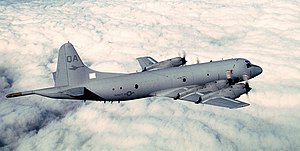P-3 Orion
| P-3 Orion | |
|---|---|
 |
|
| A P-3C Orion of Patrol Squadron 22 (VP-22) flies over Japan, 1 December 1991. | |
| Role | Maritime patrol aircraft |
| National origin | United States |
| Manufacturer |
Lockheed Lockheed Martin Kawasaki Heavy Industries |
| First flight | November 1959 |
| Introduction | August 1962 |
| Status | Active |
| Primary users |
United States Navy Japan Maritime Self-Defense Force Royal Australian Air Force Republic of Korea Navy |
| Produced | 1961–1990 |
| Number built | Lockheed – 650, Kawasaki – 107, Total – 757 |
| Unit cost |
US$36 million (FY1987)
|
| Developed from | Lockheed L-188 Electra |
| Variants |
Lockheed AP-3C Orion Lockheed CP-140 Aurora Lockheed EP-3 Lockheed WP-3D Orion |
| Developed into | Lockheed P-7 |
The Lockheed P-3 Orion is a four-engine turboprop anti-submarine and maritime surveillance aircraft developed for the United States Navy and introduced in the 1960s. Lockheed based it on the L-188 Electra commercial airliner. The aircraft is easily distinguished from the Electra by its distinctive tail stinger or "MAD Boom", used for the magnetic detection of submarines.
Over the years, the aircraft has seen numerous design advancements, most notably to its electronics packages. The P-3 Orion is still in use by numerous navies and air forces around the world, primarily for maritime patrol, reconnaissance, anti-surface warfare and anti-submarine warfare. A total of 734 P-3s have been built, and in 2012, it joined the handful of military aircraft including the Boeing B-52 Stratofortress, Boeing KC-135 Stratotanker, Lockheed C-130 Hercules and the Lockheed U-2 that have seen over 50 years of continuous use by the United States military. The U.S. Navy's remaining P-3C aircraft will eventually be replaced by the P-8A Poseidon.
In August 1957, the U.S. Navy called for replacement proposals for the piston engined Lockheed P2V Neptune (later redesignated P-2) and Martin P5M Marlin (later redesignated P-5) with a more advanced aircraft to conduct maritime patrol and anti-submarine warfare. Modifying an existing aircraft was expected to save on cost and allow rapid introduction into the fleet. Lockheed suggested a military version of their L-188 Electra, which was still in development and had yet to fly. In April 1958, Lockheed won the competition and was awarded an initial research and development contract in May.
...
Wikipedia
